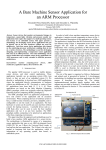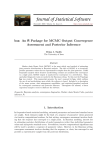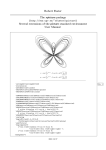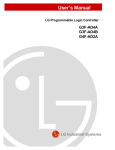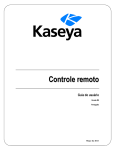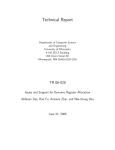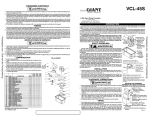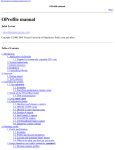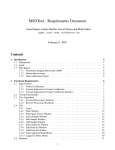Download 7-page version - University of Wisconsin–Madison
Transcript
Dynamic Kernel Code Optimization1 Ariel Tamches Barton P. Miller VERITAS Software Corporation 350 Ellis Street Mountain View, CA 94043-2237 Computer Sciences Department University of Wisconsin Madison, WI 53706-1685 [email protected] [email protected] Abstract We have developed a facility for run-time optimization of a commodity operating system kernel. Our infrastructure, currently implemented on UltraSPARC Solaris 7, includes the ability to do a detailed analysis of the running kernel's binary code, dynamically insert and remove code patches, and dynamically install new versions of kernel functions. As a first use of this technology, we have implemented a runtime kernel version of the code positioning I-cache optimizations. We performed run-time code positioning on the kernel’s TCP read-side processing routine while running a Web client benchmark, reducing the I-cache miss stall time of this function by 35.4% and improved the function’s overall performance by 21.3%. The primary contributions of this paper are the first run-time kernel implementation of code positioning, and an infrastructure for run-time kernel optimizations. A further contribution is made in performance measurement. We provide a simple and effective algorithm for deriving control flow edge execution counts from basic block execution counts, which contradicts the widely held belief that edge counts cannot be derived from block counts. 1 Introduction This paper studies dynamic optimization of a commodity operating system kernel. We describe a mechanism for replacing the code of almost any kernel function with an alternate implementation, enabling installation of run-time optimizations. As a proof of concept, we demonstrate a dynamic kernel implementation of Pettis and Hansen’s code positioning I-cache optimizations [10]. We applied code positioning to Solaris TCP kernel code while running a Web client benchmark, reducing the I-cache stall time of the TCP read-side processing routine by 35.4%. This led to a 21.3% speedup in each invocation of tcp_rput_data and a 7.1% speedup in the benchmark’s elapsed run-time, demonstrating that even I/O workloads can incur enough CPU time to benefit from I-cache optimization. Pettis and Hansen implemented code positioning in a feedback-directed customized compiler for user code, applying the optimizations off-line and across an entire program. In contrast, our implementation is performed on ker- nel code and entirely at run-time. The dynamic nature of our infrastructure allows the optimization to be focused on a desired portion of the kernel’s code; there is no need to optimize the entire system en masse, as is common with static techniques. Our implementation is the first on-line kernel version of code positioning. In the bigger picture, our dynamic kernel optimization framework is a first step toward evolving operating system kernels, which dynamically modify their code at their own behest in response to their environment. 2 Algorithm As a demonstration of the mechanisms necessary to support an evolving kernel, we have implemented run-time kernel code positioning within the KernInst dynamic kernel instrumentation system [15]. KernInst contains three components: a high-level GUI kperfmon which generates instrumentation code for performance measurement, a lowlevel privileged kernel instrumentation server kerninstd, and a small pseudo device driver /dev/kerninst which aids kerninstd when the need arises to operate from within the kernel’s address space. Kerninstd also performs a structural analysis of the kernel’s machine code, calculating control flow graphs and a call graph, as well as performing an interprocedural live register analysis. We perform code positioning as follows: (1) A function to optimize is chosen. This is the only step requiring user involvement. (2) KernInst determines if the function has an I-cache bottleneck. If so, basic block execution counts are gathered for this function and its frequently called descendants. From these counts, a group of functions to optimize is chosen. (3) An optimized re-ordering of these functions is chosen and installed into the running kernel. Interestingly, once the optimized code is installed, the entire code positioning optimization is repeated (once) – optimizing the optimized code – for reasons discussed in Section 2.1.3. 2.1 Measurement Steps The first measurement phase determines whether an I-cache bottleneck exists, making code positioning worthwhile. Next, basic block execution counts are collected for the user-specified function and a subset of its descendants. 1. This work is supported in part by Department of Energy Grant DE-FG02-93ER25176, Lawrence Livermore National Lab grant B504964, NSF grants CDA-9623632 and EIA-9870684, and VERITAS Software Corporation. The U.S. Government is authorized to reproduce and distribute reprints for Governmental purposes notwithstanding any copyright notation thereon. Page 1 Code positioning is performed not only on the userspecified function, but also the subset of its call graph descendants that significantly affects its I-cache performance. We call the collective set of functions a function group; the user-specified function is the group’s root function. The intuitive basis for the function group is to gain control over I-cache behavior while the root function executes. Because the group contains the hot subset of the root function’s descendants, once the group is entered via a call to its root function, control will likely stay within the group until the root function returns. 2.1.1 Is There an I-Cache Bottleneck? The first measurement step checks whether code positioning might help. KernInst instruments the kernel to obtain the root function’s I-cache stall time and its CPU time. If the ratio of these measurements is above a user-definable threshold (10% by default), then the algorithm continues. KernInst collects timing information for a desired code resource (function or basic block) by inserting instrumentation code that starts a timer at the code’s entry point, and stops the timer at the code’s exit point(s). The entry instrumentation reads and stores the current time, such as the processor’s cycle counter. The exit instrumentation re-reads the time and adds the delta to an accumulated total. Changing the underlying event counter that is read on entry and exit (e.g. using the UltraSPARC I-cache stall cycle counter [14]) enables measurements other than timing. Measurements made using this framework are inclusive; any events that occur in calls made by the code being measured are included. This inclusion is vital when measuring I-cache stall time, because a function’s callees contribute to its I-cache behavior. By contrast, sampling-based profilers can collect inclusive time measurements only by performing an expensive stack back-trace on each sample. Another key aspect of this framework is that it accumulates wall time events, not CPU time events. That is, it continues to accumulate events when context switched out. This trait is desirable for certain metrics (particularly I/O latency), but not for metrics such as I-cache stall time and CPU execution time. Fortunately, this problem can be solved with additional kernel instrumentation – of the lowlevel context switch handlers – to exclude events that occur while context-switched out. The complete version of this paper [16] describes this process. 2.1.2 Collecting Basic Block Execution Counts The second measurement phase performs a breadth-first call graph traversal, collecting basic block execution counts of any function that is called at least once while the root function is active (on the call stack). The block counts are used to determine which functions are hot (these are included in the group), and to divide basic blocks into hot and cold sets. The traversal begins by dynamically instrumenting the root function to collect its basic block counts. After the instrumented kernel runs for a short time (the default is 20 seconds), the instrumentation is removed and the block counts are examined. The set of statically identifiable callees of this function then have their block counts measured in the same way. Pruning is applied to the call graph traversal in two cases: a function that has already had its block execution counts collected is not re-measured, and a function that is only called from within a basic block whose execution count is zero is not measured. Because KernInst does not currently keep indirect function calls (i.e., through a function pointer) in its call graph, a function called only indirectly will not have its block counts measured. Ramifications are discussed in Section 5.4. 2.1.3 Measuring Block Counts Only When Called by the Root Function When collecting basic block execution counts for the root function’s descendants, we wish to count only those executions that affect the root function’s I-cache behavior. In particular, a descendant function that is called by the root function may also be called from elsewhere in the kernel having nothing to do with the root function. KernInst achieves this more selective block counting by performing code positioning twice – re-optimizing the optimized code. Because code replacement, the installation of a new version of a function (Section 3), is performed solely on the root function, non-root group functions only are invoked while the optimized root function is on the call stack. This invariant ensures that measured block counts during re-optimization include only executions when the root function is on the call stack; instrumentation code need not explicitly perform this check. 2.2 Choosing the Block Ordering: Code Positioning Among the functions whose basic block execution counts were measured, the optimized group contains those with at least one hot block. A hot basic block is one whose measured execution frequency, when the root function is on the call stack, is greater than 5% of the frequency that the root function is called. (The threshold is user-adjustable.) Procedure splitting is performed first. Each group function is segregated into hot and cold chunks; a chunk is a contiguous layout of either all of the hot, or all of the cold, basic blocks of a function. We always place a function’s entry block at the beginning of its hot chunk, for simplicity. To aid optimization, not only are the hot and cold blocks of a single function segregated, but all group-wide hot blocks are segregated from the group-wide cold blocks. In other words, procedure splitting is applied group-wide. Basic block positioning chooses a layout ordering for the basic blocks within a chunk. Edge execution counts, Page 2 derived using the algorithm in Section 4, are used to choose an ordering for a chunk’s basic blocks that facilitates straight-lined execution in the common case. Through a weighted traversal of these edge counts, each basic block of the function’s hot chunk is placed in a chain, a sequence of contiguous blocks that is optimized for straight-lined execution [10]. The motivation behind chains is to place the more frequently taken successor block immediately after the block containing a branch. In this way, some unconditional branches can be eliminated. For a conditional branch, placing the likeliest of the two successors immediately after the branch allows the fall-through case to be the more commonly executed path (after reversing the conditional being tested by the branch instruction, if appropriate). In general, the number of basic blocks (or instructions) in a chain gives the expected distance between taken branches. The more instructions between taken branches, the better the I-cache utilization and the lower the mispredicted branch penalty. Ideally, a function’s hot chunk is covered by a single chain. 2.3 Emitting and Installing the Optimized Code After ordering the group’s contents, KernInst generates the optimized code and installs it into the running kernel. In order to emit functions with a new ordering, KernInst first parses each function’s machine code into a relocatable representation. Next, it emits the group code, which must be relocatable, because its kernel address has not yet been determined. Procedure calls are treated specially; if the callee is a group function, then the call is redirected to the group’s version of that function. Kerninstd then allocates space for the code and resolves relocatable elements, much like a dynamic linker. Further details are in the longer version of this paper [16]. After installation via code replacement (Section 3) on the group’s root function, KernInst analyzes the group’s functions like all other kernel functions. This analysis includes parsing function control-flow graphs, performing a live-register analysis, and updating the call graph. The firstclass treatment of runtime-generated code allows the new functions to be instrumented (so the speedup achieved by the optimization can be measured, for example) and even re-optimized (a requirement, as discussed in Section 2.1.3). 3 Code Replacement Code replacement is the primary mechanism that enables run-time kernel optimization, allowing the code of any kernel function to be dynamically replaced (en masse) with an alternate implementation. Code replacement is implemented on top of KernInst’s splicing primitive [15]. The entry point of the original function is spliced to jump to the new version of the function. Code replacement takes about 68 µs if the original function resides in the kernel nucleus and about 38 µs otherwise. (The Solaris nucleus is a 4 MB range covered by a single I-TLB entry.) If a single branch instruction cannot jump from the original function to the new version of the function, then a springboard [15] is used to achieve sufficient displacement. If a springboard is required, then a further 170 µs is required if the springboard resides in the nucleus, and 120 µs otherwise. The above framework incurs overhead each time the function is called. This overhead often can be avoided, by patching calls to the original function to directly call the new version of the function. This optimization can be applied for all statically identifiable call sites, but not to indirect calls through a function pointer. Replacing one call site takes about 36 µs if it resides in the nucleus, and about 18 µs otherwise. To give a large-scale example, replacing the function kmem_alloc, including patching of its 466 call sites, takes about 14 ms. Kernel-wide, functions are called an average of 5.9 times, with a standard deviation of 0.8. (This figure excludes indirect calls, which cannot be analyzed statically.) The cost of installing the code replacement (and of later restoring it) is higher than you might expect, because /dev/kerninst performs an expensive undoable write for each call site. Undoable writes are logged by /dev/kerninst, which reverts code to its original value by if the front-end GUI or kerninstd exit unexpectedly. Kerninstd analyzes the replacement (new) version of a function at run-time, creating a control flow graph, calculating a live register analysis, and updating the call graph in the same manner as kernel code that was recognized at kerninstd startup. This uniformity is important because it allows tools built on top of kerninstd to treat the replacement function as first-class. For example, when kperfmon is informed of a replacement function, it updates its code resource display, and allows the user to measure and even re-optimize the replacement function as any other. Dynamic code replacement is undone by restoring the patched call sites, then un-instrumenting the jump from the entry of the original function to the entry of the new version. This ordering ensures atomicity; until code replacement undoing has completed, the replacement function is still invoked due to the jump from the original to new version. Basic code replacement, when no call sites were patched, is undone in 65 µs if the original function lies in the nucleus, and 40 µs otherwise. If a springboard was used to reach the replacement function, then it is removed in a further 85 µs if it resided in the nucleus, and 40 µs otherwise. Each patched call site is restored in 30 µs if it resided in the nucleus, and 16 µs otherwise. Page 3 4 Calculating Edge Execution Counts from Block Execution Counts 4.2 An Example In this section, we describe a simple and effective algorithm for deriving control flow graph edge execution counts from basic block execution counts. Edge execution counts are required for effective block positioning, but KernInst does not presently implement an edge splicing mechanism which would allow direct measurement of edge counts. However, we have found that 99.6% of Solaris control flow graph edge counts can be derived from basic block counts. This result implies that simple instrumentation (or sampling) that measures block counts can be used in place of technically more difficult edge count measurements. The results of this section tend to contradict the widelyheld belief that while block counts can be derived from edge counts, the converse does not hold. Although that limitation is true in the general case of arbitrarily structured control flow graphs, our technique is effective in practice. Furthermore, the algorithm may be of special interest to samplingbased profilers [1, 7, 8, 18], which can directly measure block execution counts but cannot directly measure edge execution counts. Figure 1 contains a control flow graph used by Pettis and Hansen to demonstrate why edge measurements are more useful than block measurements. Precise edge counts for this graph can be derived from its block counts, as follows. First, block B has only one predecessor edge (A,B) and only one successor edge (B,D), whose execution counts must each equal B’s count (1000). Now, edge (A,C) is the only successor of A whose count is unknown. Its count is 1 (A’s count of 1001 minus the count of its known successor edge, 1000). Next, edge (C,C) is the only remaining unknown predecessor edge of C. Its count equals 2000 (C’s block count of 2001 minus the count of its known predecessor edge, 1). Finally, edge (C,D) is the only unknown successor of C. Its count equals 1 (C’s block count of 2001 minus the count of its known successor edge, 2000). A block count=1001 1000 2000 1 B C block count=1000 block count=2001 4.1 Algorithm 1000 We assume that a function’s control flow graph is available, along with execution counts of the function’s basic blocks. Our algorithm calculates the execution counts of all edges of a function, precisely when possible, and approximated otherwise. Two simple formulas are used: the sum of a basic block’s predecessor edge counts equals the block’s count, which also equals the sum of that block’s successor edge counts. For a block whose count is known, if all but one of its predecessor (successor) edge counts are known, then the unknown edge count can be precisely calculated: the block count minus the sum of the known edge counts. The algorithm repeats until convergence, after which all edge counts that could be precisely derived from block counts were so calculated. The second phase of the algorithm approximates any remaining, unknown edge execution counts. Two formulas bound the count of such an edge: (1) the count can be no larger than its predecessor block’s execution count minus the sum of that block’s calculated successor edge counts, and (2) the count can be no larger than its successor block’s execution count minus the sum of that block’s calculated predecessor edge counts. We currently use the minimum of these two values as an imprecise approximation of that edge’s execution count. There are alternative choices, such as evenly dividing the maximum allowable value among all unknown edges. However, since most edge counts can be precisely derived, approximation is rarely needed, making the issue relatively unimportant. 1 D block count=1001 Figure 1: Deriving Edge Counts From Block Counts The count for edge (X, Y) can be calculated if it is the only unknown successor count of block X, or the only unknown predecessor count of block Y. Repeated application can often calculate all edge counts, as in this example (an augmented Figure 3 from [10]). 4.3 Results and Analysis Applying the above algorithm to the Solaris kernel reveals that 99.6% of its control flow graph edge counts can be derived from basic block counts. Furthermore, for 97.8% of kernel functions, we can precisely calculate counts for every one of their control flow graph edges. Thus, with few exceptions, collecting block counts is sufficient to derive edge counts. This conclusion is especially useful for samplingbased profilers, which cannot directly measure edge counts. Even where edge counting can be directly measured, deriving edge counts from block counts may be preferable because sampling can make it less expensive. For example, dcpi [1] obtains accurate measurements by sampling 5200 times per second, yet the system overhead is only 1-3%. Page 4 5 Experimental Results As a concrete demonstration of the efficacy of run-time kernel code positioning, this section presents initial results in optimizing the I-cache performance of the Solaris kernel while running a Web client benchmark. We study the performance of tcp_rput_data (and its callees), which processes incoming network data. tcp_rput_data is called thousands of times per second in the benchmark, and has poor I-cache performance: about 36% of its time is spent in I-cache misses. Using our prototype implementation of code positioning, we reduced the time per invocation of tcp_rput_data in our benchmark from 6.6 µs to 5.44 µs, a speedup of 21.3%. (We concentrate on optimizing the per invocation cost of tcp_rput_data, to achieve an improvement that scales with its execution frequency.) 5.1 Benchmark We used the GNU wget tool [6] to fetch 34 files totaling about 28 MB of data, largely comprised of Postscript, compressed Postscript, and PDF files. The benchmark contained ten simultaneous connections, each running the wget program as described over a 100 MB/sec LAN. The client machine had a 440 MHz UltraSPARC-IIi processor. The benchmark spends much of its time in the read side of TCP code, especially tcp_rput_data. We chose to perform code positioning on tcp_rput_data because of its size (about 12K bytes of code across 681 basic blocks), which suggests there is room for I-cache improvement. 5.2 tcp_rput_data Performance: Before other words, tcp_rput_data spends about 36% of its execution time in I-cache miss processing. The measured basic block execution counts of tcp_rput_data and its descendants estimate the hot set of basic blocks during the benchmark’s run. The measured counts are an approximation, both because code reached via an indirect call is not measured, and because the measurement includes block executions without regard to whether the group’s root function is on the call stack. These approximate block counts were used to estimate the likely I-cache layout of the subset of these blocks that are hot (those which are executed over 5% as frequently as tcp_rput_data is called). The estimate is shown in Figure 2a. Two conclusions about I-cache performance can be drawn from Figure 2a. First, having greater than 2-way set associativity in the I-cache would have helped, because the hot subset of tcp_rput_data and its descendants cannot execute without I-cache conflict misses. Second, even if the I-cache were fully associative, it may be too small to effectively run the benchmark. The bottom of Figure 2a estimates that 244 I-cache blocks (about 7.8K) are needed to hold the hot basic blocks of tcp_rput_data and its descendants, which is about half of the total I-cache size. Because other code, particularly Ethernet and IP processing code that invokes tcp_rput_data, is also executed thousands of times per second, the total set of hot basic blocks likely exceeds the capacity of the I-cache. 5.3 tcp_rput_data Performance: After To determine whether tcp_rput_data is likely to benefit from code positioning, we measured the inclusive CPU time that it spends in I-cache misses. The result is surprisingly high; each invocation of tcp_rput_data takes about 6.6 µs, of which about 2.4 µs is idled waiting for I-cache misses. In We performed code positioning to improve the inclusive I-cache performance of tcp_rput_data. Figure 2b presents the I-cache layout of the optimized code, estimated in the same way as in Figure 2a. There are no I-cache conflicts among the group’s hot basic blocks, which could have fit comfortably within an 8K direct-mapped I-cache. 0 0 0 0 1 1 1 0 1 1 0 0 0 1 1 2 2 2 2 2 2 2 1 1 1 1 1 1 1 2 2 2 1 0 0 0 0 0 1 1 1 1 1 1 1 1 1 1 1 1 0 0 0 0 1 1 2 0 1 1 3 2 2 1 1 2 2 0 0 0 0 0 1 1 1 1 2 2 2 1 1 2 2 2 0 1 1 3 3 3 3 1 3 2 1 1 0 1 1 1 0 0 0 0 0 0 0 2 1 1 1 1 1 1 1 1 1 2 2 3 2 2 1 2 2 1 0 0 1 1 1 0 0 0 0 0 0 0 0 0 1 0 0 0 0 0 0 0 0 0 1 0 1 0 0 1 1 1 0 0 0 0 0 0 0 0 1 0 0 0 0 0 0 1 2 1 1 1 1 2 2 1 3 3 4 4 4 3 4 4 4 3 2 1 0 0 0 0 0 0 0 0 1 1 1 1 0 0 Total # of cache blocks: 244 (47.7% of the I-Cache size) (a) Before Optimization 0 1 1 1 1 1 1 1 1 1 1 1 1 1 1 1 1 1 1 1 1 1 1 1 1 1 1 1 1 1 1 1 1 1 1 1 1 1 1 1 1 1 1 1 1 1 1 1 1 1 1 1 1 1 1 1 1 1 1 1 1 1 1 1 1 1 1 1 1 1 1 1 1 1 1 1 1 1 1 1 1 1 1 1 1 1 1 1 1 1 1 1 1 1 1 1 1 1 1 1 1 1 1 1 1 1 1 1 1 0 0 0 0 0 0 0 0 0 0 0 0 0 0 0 0 0 0 0 0 0 0 0 0 0 0 0 0 0 0 0 0 0 0 0 0 0 0 0 0 0 0 0 0 0 0 0 0 0 0 0 0 0 0 0 0 0 0 0 0 0 0 0 0 0 0 0 0 0 0 0 0 0 0 0 0 0 0 0 0 0 0 0 0 0 0 0 0 0 0 0 0 0 0 0 0 0 0 0 Total # of cache blocks: 132 (25.8% of the I-Cache size) (b) After Optimization 1 1 2 0 1 2 1 0 0 1 0 0 0 2 2 0 2 1 2 0 1 1 2 0 0 1 0 1 0 1 2 0 2 0 1 0 1 2 3 0 1 1 0 1 0 2 1 0 1 1 1 1 1 1 1 1 0 0 0 0 0 0 0 0 1 1 1 1 1 1 1 1 0 0 0 0 0 0 0 0 Figure 2: I-cache Layout of the Hot Blocks of tcp_rput_data and its Descendants (Before and After Optimization) Each cell represents a 32-byte I-cache block with a count of how many hot basic blocks with distinct I-cache tags, reside there. The UltraSPARC I-cache is 16K, 2-way set associative; highlighted cells (those with counts greater than two) indicate a likely conflict. Page 5 1 1 1 1 1 1 1 1 0 0 0 0 0 0 0 0 Figure 3 shows the functions in the optimized group along with the relative sizes of the hot and cold chunks. The figure demonstrates that procedure splitting is effective, with 77.4% of the group’s code consisting of cold basic blocks. Block positioning is also effective, with the hot chunk of most group functions covered by a single chain. Function tcp/tcp_rput_data unix/mutex_enter unix/putnext unix/lock_set_spl_spin genunix/canputnext genunix/strwakeq genunix/isuioq ip/mi_timer ip/ip_cksum tcp/tcp_ack_mp genunix/pollwakeup genunix/timeout genunix/.div unix/ip_ocsum genunix/allocb unix/mutex_tryenter genunix/cv_signal genunix/pollnotify genunix/timeout_common genunix/kmem_cache_alloc unix/disp_lock_enter unix/disp_lock_exit Totals Jump Table Data 56 0 0 0 0 0 0 0 0 0 0 0 0 0 0 0 0 0 0 0 0 0 56 Hot # Chains Cold Chunk in Hot Chunk bytes Chunk bytes 1980 44 160 32 60 108 40 156 200 248 156 40 28 372 132 24 36 64 204 112 28 36 4260 10 1 1 1 1 1 1 1 1 1 1 1 1 4 1 1 1 1 1 1 1 1 34 11152 0 132 276 96 296 36 168 840 444 152 0 0 80 44 20 104 0 52 700 12 20 14624 Figure 3: The Optimized tcp_rput_data Group The group contains a new version of tcp_rput_data, and the hot subset of its statically identifiable call graph descendants, with code positioning applied. The group’s layout consists of 56 bytes of jump table data, followed by 4,260 bytes of hot code, and finally 14,624 bytes of cold code. (Although mutex_enter is in the group, mutex_exit is not, because a Solaris trap handler tests the PC register against mutex_exit’s code bounds. To avoid confusing this test, KernInst excludes mutex_exit from group code.) Code positioning resulted in a 7.1% speedup in the benchmark’s end-to-end run-time, from 36.0 seconds to 33.6 seconds. To explain the speedup, we used kperfmon to measure the performance improvement in each invocation of tcp_rput_data. Pre- and post-optimization numbers are shown in Figure 4. 5.4 Analysis of Code Positioning Limitations Code positioning performs well unless there are indirect function calls among the hot basic blocks of the group. This section analyzes the limitations that indirect calls placed on the optimization of tcp_rput_data (and System V streams code in general), to quantify how the present inability to optimize across indirect calls constrains code positioning. The System V streams code has enough indirect calls to limit what can presently be optimized to a single streams Measurement I-$ stall time/invoc Branch mispredict stall time/invoc IPC (instrucs/cycle) Original 2.40 µs Optimized 1.55 µs Change 0.38 µs 0.20 µs -47.4% 0.28 0.38 +35.7% 6.60 µs 5.44 µs 21.3% speedup CPU time/invoc -35.4% Figure 4: Measured Performance Improvements in tcp_rput_data After Code Positioning The performance of tcp_rput_data has improved by 21.3%, mostly due to fewer I-cache stalls and fewer branch mispredict stalls. module (TCP, IP, or Ethernet). Among the measured hot code of tcp_rput_data and its descendants, there are two frequently-executed indirect function calls. Both calls are made from putnext, a stub routine that forwards data to the next upstream queue by indirectly calling the next module’s stream “put” procedure. This call is made when TCP has completed its data processing (verifying check sums and stripping off the TCP header from the data block), and is ready to forward the processed data upstream. Because callees reached by hot indirect function calls cannot currently be optimized, we miss the opportunity to include the remaining upstream processing code in the group. At the other end of the System V stream, by using TCP’s data processing function as the root of the optimized group, we missed the opportunity to include downstream data processing code performed by the Ethernet and IP processing. Across the entire kernel, functions make an average of 6.0 direct calls (standard deviation 10.6) and just 0.2 indirect calls (standard deviation 0.8). However, because indirect calls tend to exist routines that are invoked throughout the kernel, any large function group will likely contain at least one such call. 6 Related Work 6.1 Measurement An alternative to our instrumentation is sampling [1, 7, 8, 18]. Sampling measures CPU time events by periodically reading the PC, and assigning the time since the last sample at that location. Although it is simple and has constant perturbation, sampling has several limitations. First, modern CPUs having imprecise exceptions with variable delay may require hardware support to accurately assign events to instructions [5]. Second, while sampling can measure CPU time, it can only measure wall time with a prohibitive call stack back-trace of all blocked threads per sample. Third, sampling can only measure inclusive metrics by assigning time for all routines on the call stack for each sample. Aside from the expense, stack back-traces can be inaccurate due to tail-call optimizations, in which a caller removes its stack frame (and thus its call stack entry) before transferring control to the callee. Tail-call optimizations are common, found about 3,800 times in Solaris kernel code. Page 6 6.2 Dynamic Optimization References Previous work has been performed on I-cache kernel optimization of kernel code [9, 12, 13, 17], although the focus has been on static, not dynamic, optimization. Dynamo [2] is a user-level run-time optimization system for HP-UX programs. Dynamo initially interprets code to collect hot instruction sequences, which are then placed in a software cache for execution at full speed. Similar in spirit to KernInst’s evolving framework, Dynamo has several differences. First, it only runs on user-level code. It would be difficult to port Dynamo to a kernel because interpreting a kernel is more difficult. Even if possible, the overhead of kernel interpretation may be unacceptable, because the entire system is affected by a kernel slowdown. Second, Dynamo expands entire hot paths, so the same basic block can appear multiple times. This expansion can result in a code explosion when the number of executed paths is high. The PA8000 on which Dynamo runs may be able to handle code explosion, because it has an unusually large I-cache (1 MB). The same is not likely to be true for the UltraSPARC-II’s 16K I-cache. Synthetix [11] performs specialization on a modified commodity kernel. However, it requires specialized code templates to be pre-compiled into the kernel. Synthetix also requires a pre-existing level of indirection (a call through a pointer) to change implementations of a function, which incurs a slight performance penalty whether or not specialized code has been installed, and limits the number of points that can be specialized. [1] J.M. Anderson et al. Continuous Profiling: Where Have All the Cycles Gone? 16th ACM Symp. on Operating System Principles (SOSP), Saint-Malo, France, October 1997. [2] V. Bala, E. Duesterwald, and S. Banerjia. Dynamo: A Transparent Dynamic Optimization System. ACM SIGPLAN Conf. on Programming Language Design and Implementation (PLDI), Vancouver, BC, June 2000. [3] H. Cain, B.P. Miller, and B.J.N. Wylie. A Callgraph-Based Search Strategy for Automated Performance Diagnosis. European Conf. on Parallel Computing (Euro-Par), Munich, Germany, August 2000. [4] R. Cohn and P.G. Lowney. Hot Cold Optimization of Large Windows/NT Applications. IEEE/ACM International Symp. on Microarchitecture (MICRO-29), Paris, December 1996. [5] J. Dean, et. al. ProfileMe: Hardware Support for InstructionLevel Profiling on Out-of-Order Processors. 30th Annual IEEE/ACM International Symp. on Microarchitecture (MICRO-30), Research Park Triangle, NC, December 1997. [6] Free Software Foundation. GNU wget: The Non-Interactive Downloading Utility. http://www.gnu.org/software/wget/wget.html. [7] S.L. Graham, P.B. Kessler, and M.K. McKusick. gprof: a Call Graph Execution Profiler. SIGPLAN 1982 Symp. on Compiler Construction, Boston, MA, June 1982. [8] Intel Corporation. VTune Performance Analyzer 4.5. 7 Future Work Our basic block counting overhead could be lowered by combining block sampling and Section 4’s algorithm for deriving edge counts. We note that KernInst’s optimization is orthogonal to the means of measurement, because the logic for analyzing machine code, re-ordering it, and installing it into a running kernel is orthogonal to how the new ordering is obtained. With additional kernel instrumentation at indirect call sites, the call graph can be updated when a heretofore unseen callee is encountered, allowing indirect callees to be included in an optimized group [3]. User involvement in choosing the group’s root function can be removed by automating the search for functions having poor I-cache performance. Such a search can be performed by traversing the call graph using inclusive measurements [3]. Because non-root group functions are always invoked while the root function is on the call stack, certain invariants may hold that enable further optimizations [4]. For example, a variable may be constant, allowing constant propagation and dead code elimination. Other optimizations include inlining, specialization, and super-blocks. http://developer.intel.com/vtune/analyzer/index.htm. [9] D. Mosberger et. al. Analysis of Techniques to Improve Protocol Processing Latency. ACM Applications, Technologies, Architectures and Protocols for Computer Communication (SIGCOMM), Stanford, CA, August 1996. [10] K. Pettis and R.C. Hansen. Profile Guided Code Positioning. ACM SIGPLAN Conf. on Programming Language Design and Implementation (PLDI), White Plains, NY, June 1990. [11] C. Pu, et. al. Optimistic Incremental Specialization: Streamlining a Commercial Operating System. 15th ACM Symp. on Operating Systems Principles (SOSP), Copper Mountain, CO, December 1995. [12] W.J. Schmidt et. al. Profile-directed Restructuring of Operating System Code. IBM Systems Journal 37(2), 1998. [13] S.E. Speer, R. Kumar, and C. Partridge. Improving UNIX Kernel Performance Using Profile Based Optimization. 1994 Winter USENIX Conf., San Francisco, CA, 1994. [14] Sun Microsystems. UltraSPARC-IIi User’s Manual. www.sun.com/microelectronics/manuals. [15] A. Tamches and B.P. Miller. Fine-Grained Dynamic Instrumentation of Commodity Operating System Kernels. 3rd USENIX Symp. on Operating Systems Design and Implementation (OSDI), New Orleans, LA, February 1999. [16] A. Tamches and B.P. Miller. Dynamic Kernel Code Optimization. 3rd Workshop on Binary Translation (WBT). Barcelona, Spain, September 2001. [17] J. Torrellas, C. Xia, and R. Daigle. Optimizing the Instruction Cache Performance of the Operating System. IEEE Transactions on Computers, 47(12), December 1998. [18] X. Zhang, et. al. System Support for Automatic Profiling and Optimization. 16th ACM Symp. on Operating System Principles (SOSP), Saint-Malo, France, October 1997. Page 7







